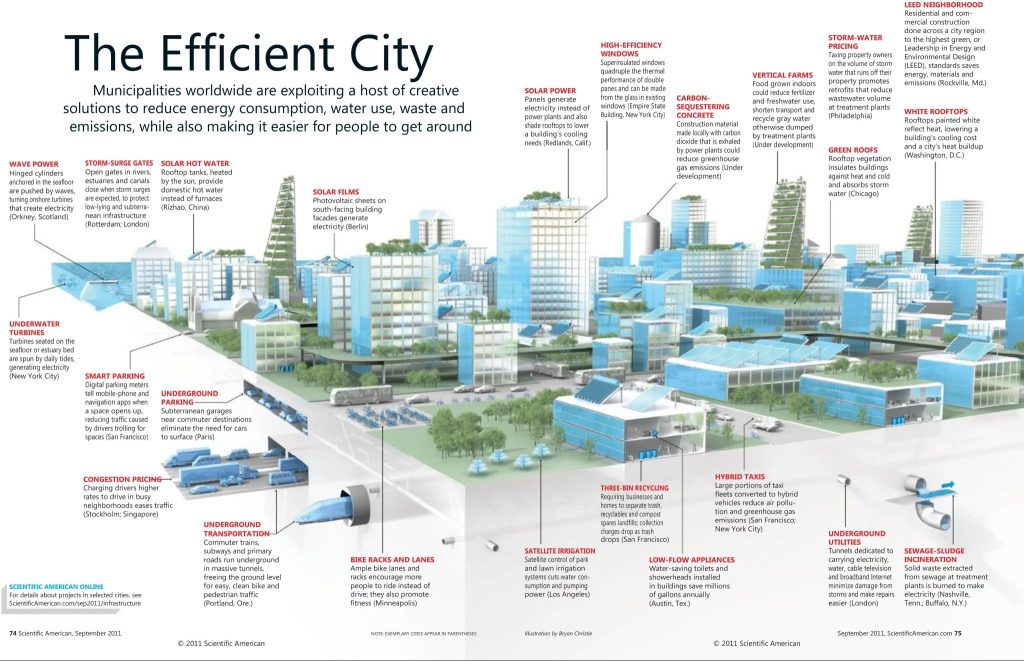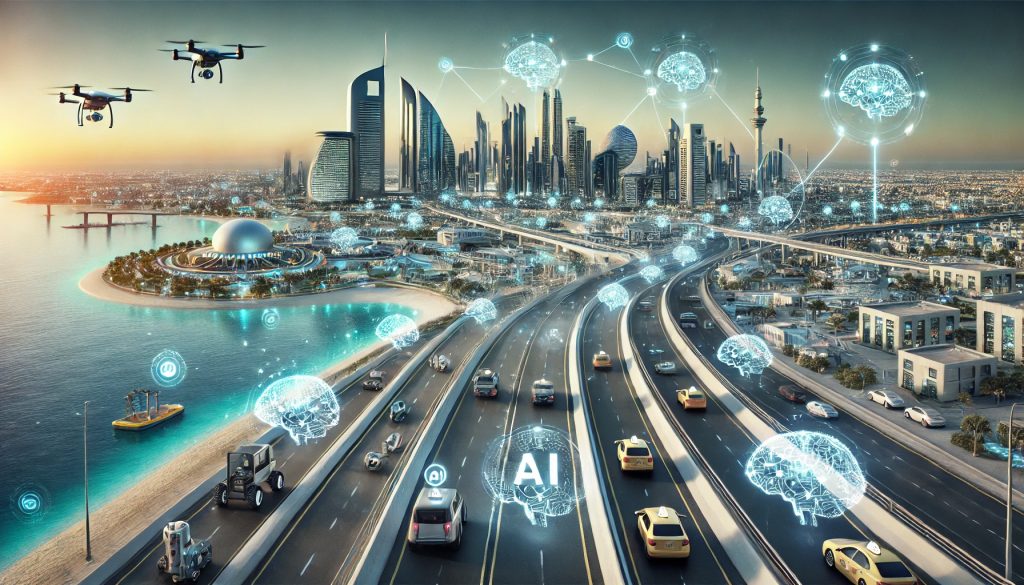and the distribution of digital products.
Building the Future: How Active Inference AI and the Spatial Web Will Transform Abu Dhabi
\ On the surface, the concept of a Smart City might seem like a futuristic dream — a world where traffic flows seamlessly, energy use is optimized, waste is managed efficiently, and every part of urban life is interconnected. However, for this to become a reality, the underlying technology must advance far beyond what we currently associate with “smart” systems. Today, the partnership between VERSES AI and Analog is paving the way for this transformation, starting with the Abu Dhabi Smart City project. This collaboration doesn’t just push the boundaries of urban technology, it fundamentally rewrites what is possible for cities across the globe.
\ In a webinar held on October 1, 2024, Gabriel Rene, Founder & CEO of VERSES AI, and Alex Kipman, Founder and CEO of Analog, openly discussed their partnership in the Smart City initiative in Abu Dhabi. The conversation revolved around their vision for transforming Abu Dhabi into a pioneering Smart City through the integration of Active Inference AI, Spatial Web technologies, and real-time sensor networks. They discussed the collaboration between VERSES AI and Analog, emphasizing the significance of creating a decentralized, adaptive infrastructure that operates like a “living organism,” leveraging real-time data to manage city-wide systems autonomously. Both Gabe and Alex explored the broader implications of their project, highlighting how Abu Dhabi could serve as a global model for urban transformation, with the potential to expand into other cities worldwide.
\ At the core of this technological revolution is Active Inference AI, a breakthrough in artificial intelligence that surpasses traditional systems like OpenAI’s ChatGPT, and other generative AI models. Through the integration of real-time data sensing and decision-making, dynamic adaptability, and optimized efficiency, enabled by the new technological advancements of Active Inference empowered Renormalizing Generative Models (RGMs), and the Spatial Web Protocol, Abu Dhabi is positioning itself not just as a Smart City, but as the template for how all future cities should be built.
What Makes a City Smart? A Look at Real-Time Data and Active InferenceFor a city to be truly “smart,” it must be able to process and respond to vast amounts of real-time data. Traditional AI systems simply aren’t up to the task. While generative models like GPT-4 have captured headlines with their ability to generate text, summarize documents, or produce creative content, they lack the ability to manage and optimize complex, dynamic environments like a city.
A city operates over multiple layers and scales — traffic management, energy distribution, waste disposal, public health and safety, logistics, communications, and many more. These layers require constant coordination and real-time adjustment to ensure optimal functioning.
\
\ Here’s the challenge: traditional AI models are static. They rely on pre-trained data sets and cannot adapt in the moment as conditions change. They are also siloed systems. Each model is trained for a specific type of operation for processing and output — language, images, sound, etc… You can connect different models within a single interface, but they are still siloed operations. For example, in ChatGPT, you can have it create images, but it is using a separate image generation model called, DALL-E, to generate those images.
\ This is why Active Inference AI stands apart — it is an entirely new kind of artificial intelligence that operates — learns, plans, and acts on its environment by way of the Free Energy Principle, a discovery by world renowned neuroscientist, Dr. Karl Friston, Chief Scientist at VERSES, that explains how all biological systems learn.
\ Active Inference empowered RGMs are an all-in-one system that serves as a versatile, universal framework that can be adapted to handle tasks such as image classification, file compression, and content generation, while performing perception, learning, reasoning, and decision-making, operating efficiently across different scales. The autonomous intelligence of Active Inference Agents enables them to continuously learn, adapt, and update their understanding of the world based on new data received through sensors, cameras, machines, robotics, etc… Their ability to predict and act in real time ensures that a city continues to function optimally, even in the face of unexpected events.
\ The capacity to process this real-time data at the edge on local devices distributed throughout the network, rather than having to be tethered to distant data centers, is essential. Edge computing enables faster response times and minimizes the risk of delays that could lead to inefficiencies or even failures in critical urban systems. This is where VERSES’ technology and Active Inference AI will lead the way.
\
But how does all this data come together in a way that’s actionable for AI systems? The answer lies in the Spatial Web. The Spatial Web Protocol: HSTP and HSML, adds another foundational layer of intelligence to the mix.
\ The Spatial Web expands the internet into a new dimension — one where physical spaces, people, objects, and data streams are connected in a real-time, 3D digital environment. This allows cities like Abu Dhabi to create a digital twin — a dynamic, real-time replica of the city’s infrastructure and operations.
\ Using Hyperspace Transaction Protocol (HSTP) and Hyperspace Modeling Language (HSML), the Spatial Web ensures that data from sensors, IoT devices, drones, and other systems is seamlessly integrated into this digital twin. HSML translates data into a language that Active Inference Intelligent Agents can understand and interact with, enabling them to perceive and act upon the world in real time.
Imagine a city where traffic lights automatically adjust to reduce congestion, energy grids optimize power distribution based on real-time consumption patterns, and autonomous drones deliver goods while avoiding no-fly zones — all managed by an intelligent network of agents working together in real time. This is the vision of Abu Dhabi’s Smart City, where Active Inference Agents distributed across the network of the Spatial Web become a layer of autonomous intelligence operating as a nervous system maintaining homeostasis within the city.
\ For a city like Abu Dhabi, this means that its infrastructure, vehicles, energy systems, buildings, and even its citizens will be part of an interconnected web — an expansion of the internet. Through HSTP and HSML, all these entities will speak the same language, enabling them to interact, share data, and function autonomously with minimal human oversight.
\
The Spatial Web represents a major leap forward in interoperability. In today’s world, AI systems, IoT devices, and networks often function in silos. The Spatial Web integrates them into a single framework, ensuring that everything from self-driving cars and traffic sensors to energy grids and emergency systems can communicate seamlessly. This is essential for managing the complex interplay of systems required to run a modern city.
Active Inference AI vs. Generative AI: Why Real-Time Sensing is CriticalUnlike traditional deep learning Generative AI models, which rely on static pre-trained data, Active Inference is dynamic and predictive. It doesn’t just respond to problems — it anticipates them, using RGMs to understand and process multiple data layers simultaneously.
\ The genius of Renormalizing Generative Models lies in their ability to break down complex data into hierarchical structures, simplifying real-time processing without sacrificing accuracy. RGMs can interact with their environment to provide context-aware decision-making through an interconnected web of systems that understand and adjust to both physical and digital contexts at any scale.
\ Whether it’s managing the daily challenges of traffic flow, optimizing energy usage, and dynamically adjusting waste management processes, or handling unpredictable circumstances like disaster relief efforts, Active Inference empowered RGMs ensure that the city operates at peak efficiency — optimizing resources at both local and city-wide levels. They achieve this while using less data and less computational power than traditional AI systems, which is why they are the key to building scalable, sustainable Smart Cities.
\ OpenAI models like GPT-4, while revolutionary in their own right, are not designed for the real-time, dynamic environments of urban management. They are excellent at pattern recognition and generating human-like text, but when it comes to managing the complexities of a city’s ever-evolving complex nested ecosystem of multi-scale systems, spaces, and people, they fall short.
\ Active Inference Agents, distributed across the Spatial Web as a layer of adaptable, self-organizing intelligence, are crucial for autonomous, real-time urban management. These agents will be able to continuously adapt to ever-changing spatial environments, establish a real-world model, and bridge various technologies by utilizing a common language. This integration represents the only viable solution for managing complex urban dynamics at this level.
Building Abu Dhabi's Smart City: A Convergence of TechnologiesThe deployment of Active Inference AI, RGMs, and the Spatial Web Protocol in Abu Dhabi is a testament to the convergence of emerging technologies. These innovations are not isolated systems but interconnected layers of intelligence that together enable a level of real-time urban management that is unprecedented. Each technology enhances the others, creating a city that is not only smarter but more adaptive and resilient.
\
Real-Time Decision Making: With Active Inference AI, the Smart City will be able to continuously monitor and adjust its operations in real time. This goes far beyond traditional systems that are reactive; Active Inference AI anticipates needs, minimizing inefficiencies before they arise.
\
Data Integration and Simplification: RGMs allow the AI to process massive amounts of data from multiple sources, organizing it into manageable structures that can be used for immediate decision-making. Whether it’s predicting water demand for agricultural zones or coordinating autonomous vehicle fleets for public transportation, the system can adapt dynamically to real-world conditions.
\
Seamless Interoperability: The Spatial Web provides the foundation for connecting all the disparate systems within a city into a single, unified framework. Through HSTP and HSML, the city’s infrastructure, sensors, and digital assets communicate with each other in real time, creating a comprehensive model of the city’s operations.
\
A Foundation for Human Machine Cooperation: Through HSML, human laws and guidelines can be made programmable so that these Intelligent Agents can understand and abide by them in real-time, offering unprecedented levels of collaboration between humans and autonomous systems, which will undoubtedly contribute to inclusivity, sustainability, and AI governance.
The Abu Dhabi Smart City project is not just about improving one city’s infrastructure, it’s about setting a new standard for urban living around the world. As cities across the globe face challenges related to population growth, climate change, and resource management, the need for intelligent, adaptable solutions will only increase.
\ When asked why Abu Dhabi was chosen as the starting point for this transformative Smart City initiative, the answer is simple: the city is a blank canvas. Unlike many major cities across Europe and the U.S., Abu Dhabi isn’t burdened by legacy infrastructure or outdated systems that often slow down innovation elsewhere. In fact, just over 50 years ago, Abu Dhabi was largely desert. Today, it is an ultra-modern metropolis with an openness to cutting-edge technology that makes it the ideal testing ground for the future of urban living.
\ By implementing Spatial Web technologies and Active Inference AI, Abu Dhabi is positioning itself as a global leader in smart infrastructure. This project is not just about building a better city, it’s about creating the blueprint for all future cities. What works in Abu Dhabi will inevitably spread, with every major city in Europe and the U.S. likely to start the transition in the next five years.
\
The VERSES and Analog partnership represents a leap forward in the development of Smart Cities, with Abu Dhabi leading the way. By integrating Active Inference AI, Renormalizing Generative Models (RGMs), and the Spatial Web Protocol, this project is redefining what’s possible for urban management. More than just optimizing current systems, these technologies create a city that is constantly learning, evolving, and adapting to the needs of its residents.
\ As the first city to fully embrace this new model, Abu Dhabi is setting the stage for a global shift in how cities are built and managed. The benefits are too significant to ignore.
\ With Active Inference AI, cities will no longer be passive environments. The Smart Cities of the future will not just be more efficient, they will be living, breathing entities, capable of sensing, predicting, and responding to the world around them.
\ The initiative between VERSES AI and Analog in Abu Dhabi isn’t just about technology — it’s about reinventing urban life. By incorporating Active Inference AI, Spatial Web technologies, and RGMs, Abu Dhabi is creating a new standard for cities, one that integrates all aspects of the digital and physical world into a unified, intelligent system.
\ In the coming years, the lessons learned from Abu Dhabi will inform the development of Smart Cities across the globe, ushering in a new era of intelligent, sustainable urban living — one where technology and humanity are seamlessly integrated, and the city itself becomes a partner in the well-being of its citizens.
\
Explore the future of Active Inference AI with me, and gain insights into this revolutionary approach and groundbreaking research!
\ I have E-Learning Courses launching mid-October 2024. Join the waitlist now to be informed when they are available.
\ Become a Substack Member to receive the Ultimate Resource Guide for Active Inference AI, and to gain access to my exclusive monthly Learning Lab LIVE sessions.
\ Visit my blog at https://deniseholt.us/, and Subscribe to my Spatial Web AI Podcast on YouTube, Spotify, and more. Subscribe to my newsletter on LinkedIn.
\ \
- Home
- About Us
- Write For Us / Submit Content
- Advertising And Affiliates
- Feeds And Syndication
- Contact Us
- Login
- Privacy
All Rights Reserved. Copyright , Central Coast Communications, Inc.



